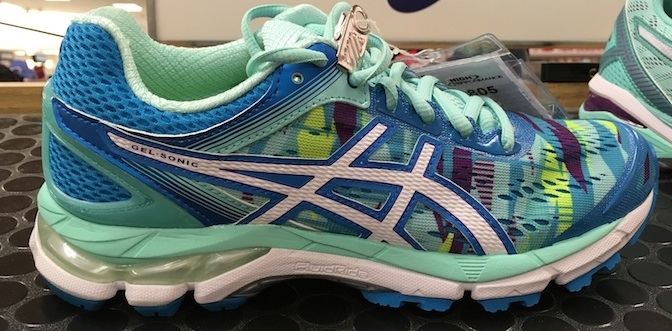

Shoe Drop
An interesting term that I ran across while researching athletic shoes is shoe drop. This term refers to the height difference between a shoe’s heel and forefoot, and it’s measured in millimeters.
Drop may also be referred to as heel to toe drop, heel toe offset, heel toe differential, or heel toe lift.
A shoe’s drop might be important to runners, especially, because it can affect how your foot strikes the ground.
Measuring Shoe Drop
A drop of 0 to 4 millimeters (zero drop to low drop) helps with a more natural strike at the midfoot. This type of shoe is best for neutral runners. (See the foot type section of this website for more information.) The recent trendy “minimal” shoes that mimic barefoot running are an example of zero drop shoes.
A drop of 4 to 8 millimeters provides cushioning for runners with high arches and stability for people who overpronate.
A larger drop of 8 to 12
millimeters will make it more likely that you will strike the ground with your
heel as you run. If you naturally
land heel to toe, a shoe with a large drop may be right for you.
The flatter the shoe, or the lower its drop, the more your midfoot will strike the ground. This is considered the most natural stride and the one that sends the least amount of shock up your leg when running, potentially lessening your chance of injury. But if you don’t naturally strike the ground this way, you may not be comfortable with the lack of cushioning in the heel.
 Shoe drop is especially important in running shoes.
Shoe drop is especially important in running shoes.Drop for Different Shoe Types
You will most likely see the term drop being discussed with running shoes since it involves the amount of cushioning and the way your foot strikes the ground when you are running. But it occasionally shows up with shoes for other sports.
In tennis, for instance, low or zero drop shoes are encouraged as a way to minimize ankle injuries. With all the lateral movements that happen on the court, the thought is that the lower your heel is to the ground, the less chance you have of rolling your ankle when you move quickly side to side.
Basketball and volleyball, conversely, involve more jumping and therefore usually call for more cushioning than zero drop shoes would provide.
What's Right for You?
If drop or offset is a new term to you, you should probably first try to determine what the drop of your current shoe is. If you are comfortable with what you’ve been wearing, it may not be wise to make any major changes. If you go from a high drop to a low drop too suddenly, you might feel some discomfort in your Achilles tendon or your lower leg muscles because of the stress put on those areas with less cushion.
But if you decide to try a different drop than what you are used to in an attempt to provide more or less cushioning or to help with your gait, then be sure to allow yourself a period of adjustment so you don’t injure yourself. Some people even have a variety of shoes with different drops, and they use one type on short runs and another on longer runs or other activities. Rotating shoes in this way can help you avoid injuries that come from repetitive stress.
As with any shoe feature, what works for one person does not always work for another. It’s important that you try the shoes on and see what feels most comfortable. Drop is just another element that can help you find your best fit.
